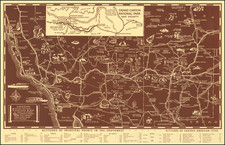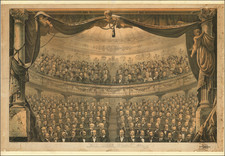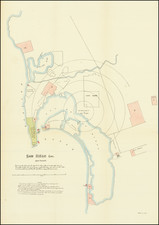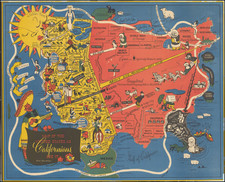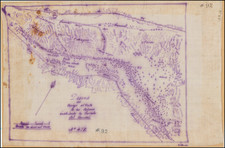Finely executed set of four pencil sketches of Yosemite, drawn in 1887, shortly before Yosemite National Park was established in 1890.
The sketches are from album of 'sketches made on a trip round the world' by Edward Morrison de Courcy Short, b.1857, who attended Charterhouse School, Surrey (1870-6). He passed the Ceylon Civil Service exam in 1878, and in 1905 became Chairman of the Municipal Council and Mayor of Colombo, retiring in 1910.
The four views are (1) Yosemite Falls (from Yosemite Valley--viewed from east of the falls); (2) Vernal Falls; (3) Untitled view of Nevada Falls (from below the falls and Mist Trail, with a structure in the foreground--most likely La Casa Nevada, also known as Snow's Hotel (1870-1890); and (4) Yosemite Valley (the classic view which can now be seen just after passing through the Tunnell into the Valley).
The sketches provide a fascinating early view of Yosemite from the perspective of an early British Tourist, who was clearly a skilled artist as well. The first and third sketches are especially interesting, providing ephemeral details of Yosemite which no longer exist. The first sketch (upper left) shows images of fence posts and an orderly well planted line of trees along a path, a reflection of the early efforts to farm and exploit the Valley).
The third sketch (lower left), is perhaps the most interesting. The sketch shows an early structure below the "Old Cabin" described as being just below Register Rock on the trail to Vernal Falls, in Chapter VIII of George MacKenzie's Yosemite: Where to Go and What to Do (1888). The structure may have been used as a toll-house built by Albert Snow (who built the trail to Vernal Falls) and would almost certainly seem to be La Casa Nevada, better known as Snow's Hotel.
In 1870, Albert Snow constructed a horse trail from "Register Rock", at the start of Mist Trail, over the rugged shoulder on which Clark point is located, to the flat between Vernal and Nevada Falls. Here he constructed a hotel known as "La Casa Nevada". In Chapter 5 of John W. Bingaman's Pathways: A Story of Trails and Men (1968), come the following passage:
The first known trail builder in the Yosemite Valley was Albert Snow, who built the horse trail zigzags up to Clark Point and thence down to the Silver Apron in 1870. This trail can be picked up at Register Rock and generally follows the new trail but is much steeper. Just after you cross the bridge near Silver Apron, if you turn right you can find a section of this trail that leads directly to the site of the Casa Nevada. Snow probably built the wagon road which went from the Casa Nevada along the north side of the river to the edge of the cliff at the top of Vernal Falls. Sections of the road are in surprisingly good condition. There were the remains of an old shack where it terminated. . . .
This early pioneer hotel was built and operated by Mr. and Mrs. Albert Snow. It was famous for its excellent meals. It was midway between the top of Vernal and the foot of Nevada Falls. In 1869-1870, Albert Snow built a horse trail from Yosemite Valley to this flat near Vernal Falls. The Snow Hotel opened April 28, 1870. It was destroyed by fire in 1890.
The following passage is from Chapter XXV of James M. Hutching's In the Heart of the Sierras (1888),
This hospice is situated about midway between the top of the Vernal, and foot of the Nevada Falls.' It has become deservedly famous all over the world, not only for its excellent lunches and general good cheer, but from the quiet, unassuming attentions of mine host, and the piquant pleasantries of Mrs. Snow. I do not think that another pair, anywhere, could be found that would more fittingly fill this position. And, although they do not know whether the number to lunch will be five or fifty-five, they almost always seem to have an abundance of everything relishable. On one occasion-and this will illustrate Mrs. Snow's natural readiness with an answer-a lady, seeing so great a variety upon the table, with eager interest inquired, "Why! Mrs. Snow, where on earth do you get all these things?" "Oh! we raise them!" "Why! where can you possibly do so, as I see nothing but rocks around here?" "Oh! madam, we raise them-on the backs of mules!"
From the porches of the Casa Nevada, and its comfortable "cottage," the glorious Nevada Fall, where the whole Merced River makes a leap of over six hundred feet, a magnificent view is obtained. The roar of this fall, and the billowy mists that in early spring roll out such eddying and gusty masses of spray, arched by rainbows on every sun-lighted afternoon, will cap tivate and charm our every emotion. The best view, probably, of this sublime spectacle is from the foot-bridge, over the hurrying and wave-surging river. There a scene is presented that fills the soul to overflowing with reverential and impressive awe; as, with uncovered head, the self-prompted mental question is in silence asked, "Is not this the very footstool of his throne?"
"The Nevada Fall is," says Prof. J. D. Whitney, "in every respect, one of the grandest water-falls in the world; whether we consider its vertical height, the purity and volume of the river which forms it, or the stupendous scenery by which it is environed." This is an opinion that I have frequently heard expressed by travelers from many lands. When in front of it, and looking upward, it can readily be seen that this fall differs in form with either of the others; for, although it shoots over the precipice in a curve, it soon strikes the smooth surface of the mountain, and spreads out into a sheet of marvelously snowy whiteness, and of burnished brightness, widening as it descends, until it sometimes exceeds one hundred feet in breadth, at the pool into which it is leaping. The height of this fall is given at six hundred and five feet by the Wheeler U. S. Survey corps.
This point being as near as visitors generally go-although many enthusiastic climbers and appreciative lovers of the beautiful seek the wonderful view from its top-we will, for the present, if you please, ask the guide to take our horses down to Register Rock, while we say good-by to our genial host and his wife, and then seek the wondrous scenes below, afoot.
Our brief search on the web and in various archives suggests that very few illustrations (photographic, printed or otherwise) of Snow's Hotel have survived.
Top Right - 4 1/2 x 6 1/2;
Bottom Left - 5 1/2 x 7 1/4;
Bottom Right - 8 x 5 1/4.









![[Coastal Orange County] Santa Ana Quadrangle](https://storage.googleapis.com/raremaps/img/small/83561.jpg)
